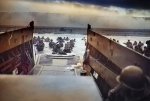81 years ago today, D-Day - never forget.
June 6, 1944: It’s Tuesday - today marks the D-Day Invasion at Normandy and the beginning of the liberation of Europe.
Operation Overlord - the largest seaborne invasion in history - begins. In Normandy, France, just after midnight, the US 101st and 82nd Airborne Divisions are dropped inland from the right flank beach. The British 6th Airborne Division is landed inland from the left flank beach. These forces achieve their objectives and create confusion among the German defenders. The Allied Expeditionary Force lands in Normandy at dawn. Forces of the 21st Army Group (Field Marshal Montgomery) commands the US 1st Army (General Bradley) on the right and the British 2nd Army (General Dempsey) on the left. There are five invasion beaches: Utah on the right flank, Omaha, Gold, Juno and Sword, on the left flank. At Utah, the US 7th Corps (General Collins) lands with US 4th Division spearheading the assault. The troops advance inland against light resistance. Admiral Moon provides naval support. At Omaha, the US 5th Corps (General Gerow) lands. There is heavy resistance and by the end of the day the American forces have advance less than one mile inland.
Admiral Hall provides naval support. At Gold, the British 30th Corps (General Bucknall) lands with 50th Infantry Division and 8th Armored Brigade leading the assault. There is reasonable advance inland although the assigned objectives are not met. At Juno beach, the British 1st Corps (General Crocker) lands with the Canadian 3rd Infantry Division and the Canadian 2nd Armored Brigade leading the assault. The tanks and infantry quickly push inland. Naval support is under the command of Commodore Oliver. At Sword beach, other elements of the British 1st Corps land. The British 3rd Infantry Division, 27th Armored Brigade and several Marine and Commando units lead the assault. The beach is quickly secured and bridges over the Orne River are captured but the first day objectives are not reached. The German 21st Panzer Division counterattacks in the late afternoon but does not dislodge the British defenders. Naval support and massive aerial interdiction prevents the German defenders from concentrating forces for a decisive counterattack. By day’s end, approximately 156,000 Allied troops have successfully stormed Normandy’s beaches. According to some estimates, more than 4,000 Allied troops lost their lives in the D-Day invasion, with thousands more wounded or missing.
Less than a week later, on June 11, the beaches were fully secured and over 326,000 troops, more than 50,000 vehicles, and some 100,000 tons of equipment had landed at Normandy.
Allied air forces - including 3,467 heavy bombers, 1,645 medium and light bombers, 5,409 fighters, and 2,316 transports - fly more than 14,000 sorties over Normandy.
This digitally colorized image of “Into the Jaws of Death,” a photograph by Robert F. Sargent of the United States Coast Guard, shows troops disembarking from a landing craft onto Omaha Beach on June 6, 1944.

June 6, 1944: It’s Tuesday - today marks the D-Day Invasion at Normandy and the beginning of the liberation of Europe.
Operation Overlord - the largest seaborne invasion in history - begins. In Normandy, France, just after midnight, the US 101st and 82nd Airborne Divisions are dropped inland from the right flank beach. The British 6th Airborne Division is landed inland from the left flank beach. These forces achieve their objectives and create confusion among the German defenders. The Allied Expeditionary Force lands in Normandy at dawn. Forces of the 21st Army Group (Field Marshal Montgomery) commands the US 1st Army (General Bradley) on the right and the British 2nd Army (General Dempsey) on the left. There are five invasion beaches: Utah on the right flank, Omaha, Gold, Juno and Sword, on the left flank. At Utah, the US 7th Corps (General Collins) lands with US 4th Division spearheading the assault. The troops advance inland against light resistance. Admiral Moon provides naval support. At Omaha, the US 5th Corps (General Gerow) lands. There is heavy resistance and by the end of the day the American forces have advance less than one mile inland.
Admiral Hall provides naval support. At Gold, the British 30th Corps (General Bucknall) lands with 50th Infantry Division and 8th Armored Brigade leading the assault. There is reasonable advance inland although the assigned objectives are not met. At Juno beach, the British 1st Corps (General Crocker) lands with the Canadian 3rd Infantry Division and the Canadian 2nd Armored Brigade leading the assault. The tanks and infantry quickly push inland. Naval support is under the command of Commodore Oliver. At Sword beach, other elements of the British 1st Corps land. The British 3rd Infantry Division, 27th Armored Brigade and several Marine and Commando units lead the assault. The beach is quickly secured and bridges over the Orne River are captured but the first day objectives are not reached. The German 21st Panzer Division counterattacks in the late afternoon but does not dislodge the British defenders. Naval support and massive aerial interdiction prevents the German defenders from concentrating forces for a decisive counterattack. By day’s end, approximately 156,000 Allied troops have successfully stormed Normandy’s beaches. According to some estimates, more than 4,000 Allied troops lost their lives in the D-Day invasion, with thousands more wounded or missing.
Less than a week later, on June 11, the beaches were fully secured and over 326,000 troops, more than 50,000 vehicles, and some 100,000 tons of equipment had landed at Normandy.
Allied air forces - including 3,467 heavy bombers, 1,645 medium and light bombers, 5,409 fighters, and 2,316 transports - fly more than 14,000 sorties over Normandy.
This digitally colorized image of “Into the Jaws of Death,” a photograph by Robert F. Sargent of the United States Coast Guard, shows troops disembarking from a landing craft onto Omaha Beach on June 6, 1944.








